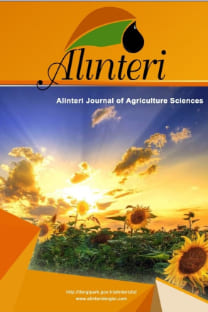Kurşuna Maruz Bırakılan Tilapia (Oreochromis mossambicus)’nın Eritrosit Morfolojisinde Görülen Değişimler
Bu çalışmada, in vivo etkide farklı kurşun konsantrasyonlarına maruz bırakılan tilapia (Oreochromis mossambicus, L.1758) balığının eritrosit morfolojisinde meydana gelen değişimler araştırılmıştır. Balıklar düşük (0,5 mg L-1), orta (2,5 mg L-1) ve yüksek (5 mg L-1) kurşun konsantrasyonlarına semi-statik olarak 14 gün boyunca maruz bırakılmıştır. Deneme sonunda orta ve yüksek doz kurşuna maruz bırakılan gruplarda kontrol grubuna göre önemli değişimler görülmüştür (p<0,05). Orta ve yüksek dozlarda kurşun eritrosit çekirdek alanı, uzunluğu ve genişliğinde kontrole göre önemli azalmaya neden olurken, sitoplazma alanı ve hücre genişliğinde kontrol grubuna göre önemli bir artma göstermiştir (p<0,05). Artan kurşun konsantrasyonlarının O. mossambicus eritrosit hücre morfolojisinde hipertrofi, anizositoz ve karyopiknozise neden olabileceği sonucuna varılmıştır.
Anahtar Kelimeler:
Kurşun, Oreochromis mossambicus, Eritrosit Morfolojisi
Changes in Erythrocyte Morphology of Tilapia (Oreochromis mossambicus) Exposed to Lead
In this study, changes of erythrocyte morphology of Tilapia (Oreochromis mossambicus, L.1758) exposing to the different concentrations of lead have been investigated. Fish were exposed to low (0,5 mg L-1), medium (2,5 mg L-1) and high (5 mg L-1) lead concentrations semi-statically during 14 days. At the end of the experiment, important changes in the treatment groups exposed to medium and high lead concentrations were shown than the control group (p<0.05). Medium and high doses of lead red blood cell nucleus area, an important reduction in the length and width compared to the control, while the width of the cell cytoplasmic space and the control group showed a significant increase (p<0.05). It was concluded that increasing lead concentrations might cause hypertrophy, anisocytosis and cariopicnosis in erythrocyte cell morphology of O. mossambicus.
Keywords:
Lead, Oreochromis mossambicus, Erythrocyte morphology,
___
- Akahori, A. Jozwiak, Z. Gabryelak, T. ve Gondko, R. 1999. Effect of Zinc on Carp (Cyprinus carpio L.) Erythrocytes. Comparative Biochemistry and Physiology, Part C: Pharmacology Toxicology and Endocrinology, 123, 209-215.
- Ay, Ö. Kalay, M. ve Canlı, M. 1999. Copper and Lead Accumulation in Tissues of Freshwater Fish Tilapia zillii and Its Effects on the Branchial Na, K-ATPase Activity. Bull. Environ. Con- tam. Toxicol., 62,160-168.
- Berman, E. 1980. Lead in “Toxic Metals and Their Analysis”. Heyden and Son LTD., London, 177- 182.
- Cavas, T . Garanko, N. ve Arkhipchuk, V. 2005. Induction of Micronuclei and Binuclei in Blood, Gill and Liver Cells of Fishes Subchronically Exposed to Cadmium Chloride and Copper Sulphate. Food and Chemical Toxicology, 43, 569-574.
- Demayo, A. Taylor, M.C. Taylor, K.W. ve Hodson, P.V. 1982. Toxic Effects of Lead and Lead Compounds on Human Health, Aquatic Life, Wildlife Plants and Livestock. CRC Crit. Rev. Environ. Control, 12, 257-305.
- De Michele, S.J. 1984. Nutrition of Lead. Comp. Biochem. Physiol. 78, 401-408.
- Eisler, R. 1988. Lead Hazards to Fish, Wildlife, and Invertebrates: A Synoptic Review. U.S. Fish Wildlife Service Biology Report, 85,1-14.
- Hawkey, C.M. Benet, P.M. Gascoyne, S.C. Hart, M.G. ve Kirkwood, J.K. 1991. Erythrocyte Size, Number and Hemoglobin Content in Vertebrates. British Journal of Haematology, 77, 392 - 397.
- Hinton, D.E. 1993. Toxicologic Histopathology of Fishes: A Systemic Approach and Overview. In: Pathobiology of Marine and Estuarine Organisms, Couch J.A. ve Fournie J.W., Eds. CRC Press: Boca Raton, 177-216.
- Hodson, P.V. 1976. Delta-amino Levulinic Acid Dehydratase Activity of Fish Blood as an Indicator of a Harmful Exposure to Lead. J. Fish. Res. Board Can., 33, 268-271.
- Hofer, R. 1992. Heavy Metal Intoxication of Arctic Charr (Salvelinus a. alpinus) in a Remote Acid Alpine Lake. EIFAC/XVII/Symp. E31 Lugano 1.
- Logan, M. 2010. Biostatistical Design and Analysis Using R: A Practical Guide. Wiley- Blackwell, London. 546s.
- Oliveira Ribeiro, C.A. Filipak Neto, F. Mela, M. Silva, P.H. Randi, M.A.F. Rabitto, I.S. Alves Costa, J.R.M. Pelletier, E. 2006. Hematological Findings in Neotropical Fish Hoplias malabarcius Exposed to Subchronic and Dietary Doses of Methylmercury, Inorganic Lead, and Tributyltin Chloride. Environ. Res. 101, 74.
- Romero, D. Hernandez-Garcia A., Tagliati C A., Martinez-Lopez E., Garcia-FernandezA J., 2009. Cadmium- and Lead-Induced Apoptosis in Mallard Erythrocytes (Anas platyrhynchos). Ecotoxicol. Environ. Saf.72, 37.
- Ruparelia, S.G. Verma, Y. Mehta, N.S. ve Salyed, S.R. 1989. Lead- Induced Biochemical Changes in Freshwater Fish Oreochromis mossambicus. Bull. Environ. Contam. Toxicol., 43, 310-314.
- Schmitt, C.J. Dwyer, F. J. ve Finger, S. E. 1984. Bioavailability of Pb and Zn from Mine Tailings as Indicated by Erythrocyte -Aminolevulinic Acid Dehydratase (ALA-D) Activity in Suckers (Pisces: Catostomidae). Can. J. Fish. Aquat. Sci., 41, 1030-1040.
- Smith, C. Shaw, B. ve Handy, R.D. 2007. Toxicity of Single Walled Carbon Nanotubes to Rainbow Trout, (Oncorhynchus mykiss): Respiratory Toxicity, Organ Pathologies, and Other Physiological Effects. Aquatic Toxicology, 82(2), 94-109.
- Tomova, E .S. Velcheva, E. G. ve Arnaudov, A.D. 2009. Influence of Copper And Zinc on the Erythrocyte-Metric Parameters of Carassius gibelio (Pisces, Cyprinidae)Bulgarian Journal of Agricultural Science, 15 (3), 183-188.
- Val, A.L. De Menezes, G.C. ve Wood, C.M. 1998. Red Blood Cell Adrenergic Responses in Amozonion Teleost. J. Fish. Biol., 52,83-93.
- Witeska, M. Kondera, E. Szymanska, M. Ostrysz, M. 2010. Hematological Changes in Common Carp (Cyprinus carpio L.) After Short-Term Lead (Pb) Exposure. Polish J. of Environ. Stud. Vol. 19, No. 4, 825-831.
- Wong, P.T.S. Silverberg, B.A. Chau, Y. K. ve Hodson, P. V. 1978. Lead and the Aquatic Biota. 279- 342 in J.O. Nriagu (ed.). The Biogeochemistry of Lead in the Environment. Part B. Biological Effects. Elsevier/North Holland Biomedical Press, Amsterdam. 397s.
- ISSN: 2564-7814
- Başlangıç: 2007
- Yayıncı: Adem Yavuz SÖNMEZ
